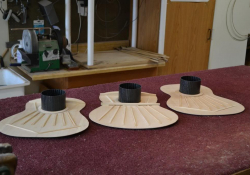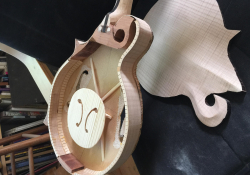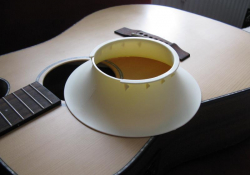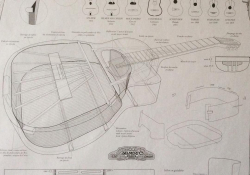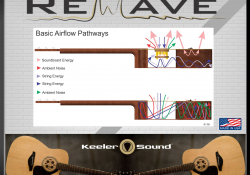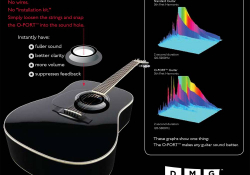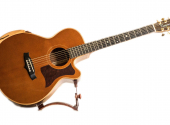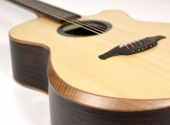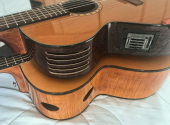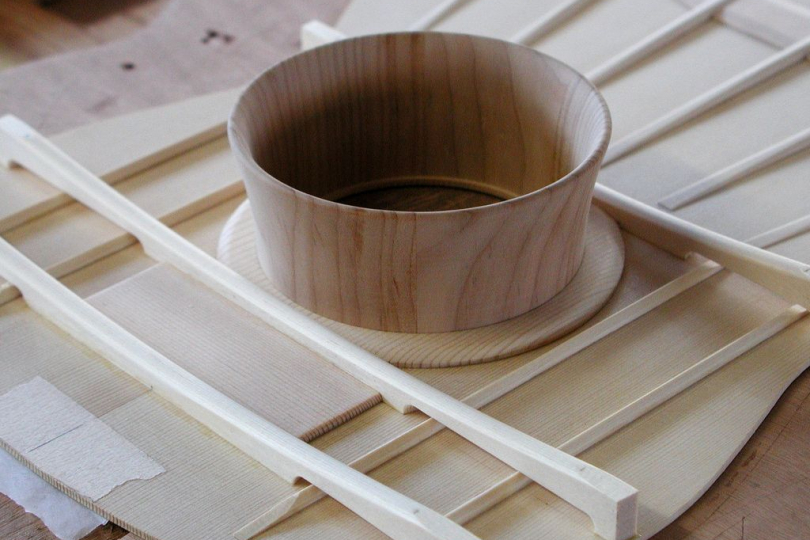
Laboratorium of Dr. Hyenik #9: Guitar Bass Reflex
From the very beginning, the acoustic guitar has been accompanied by attempts to amplify and optimize its sound. For example, the legendary Antonio Torres, also known as the "father of the guitar", experimented with a unique design called the tornavoz as early as the 19th century. And as we shall see, he was far from alone in this endeavour.
After 1800, the guitar began to change from a predominantly accompaniment instrument to a solo one and it was necessary to increase its volume and sonority, including a more pronounced expression in the deeper registers. Therefore, in addition to gradually enlarging the body and adding lower strings (as is engagingly recounted in the History Of Guitar), a double top was explored. Also, wild experiments and crazy inventions were made, from a metal band attached to the end block and the bridge (whose vibrations were amplified by an attached tube that stirred the air inside the body) to a set of glass tubes placed under the bridge to cultivate sound and prolong reverberation.
As we can read in the book on the life of Antonio Torres, he only became more prominent thanks to his tornavoz, or turned voice, inspired by the speaking trumpets of pulpit speakers, that amplified and turned the sound towards the audience in the then non-electrified concert halls. The conical tube, made at first of thin bronze plate perforated at the lower flared end for better sound distribution, became a standard sound enhancement at the time and was also made in many modifications of wood, copper, glass, cardboard, paper (and today of plastic or carbon). However, thanks to the rapid improvements in guitar construction, by the end of the century the tornavoz had gradually disappeared, as it essentially made it impossible to access the inside of the guitar for any repairs without the complicated removal of the back, and despite clearly positive sonic benefits to listeners, players complained that they were hearing themselves less.
The half-forgotten tornavoz was followed up before the wars by Virzi Tone Producer – a light and flexible spruce plate with feet first mounted under the bridge of instruments such as violin and mandolin, but also e.g. in Gibson L-5 guitars. It was intended to add and reinforce aliquot tones thanks to vibrations different from the top plate connected to the sides. Another example from that time is the legendary Mario Maccaferri, who developed an internal resonator in his Selmer gipsy jazz guitars – an internal structure attached to the top plate, which works great as a bass reflex and is an acoustic equalizer in a way, however, it didn't really catch on in the end either, due to the manufacturing and subsequent service complexity.
Keeler Sound has attempted to modernize the tube resonator into a soundhole with a product called ReWave, but a couple of years later we haven’t heard any news, so this attempt was obviously not successful. Unlike the dusted-off idea about tornavoz that survived in actual secrecy with only a few classical guitar makers. The world-famous Planet Waves company took it up vigorously and gave its reincarnation, called O-port, a strong enough marketing boost. And although it has also gradually faded away, it is still available in some e-shops.
I've been dealing with O-port quite intensely because it intersects with my project "how to get basses out of a small body". I have it installed in four of my guitars, but not in a few others. Which is also part of the answer as to why it didn't end up being marketed more massively. It's not a one-size-fits-all solution, it works great in some guitars, not so much in others. The marketing flyers promise a fuller sound, better legibility, higher volume and resistance to feedback. Which I found proven while testing it on a cheap semi-massive guitar Cort, with the funny detail that with the O-port the flageolets were almost "popping" out of the fingerboard, so if nothing else it must have some effect on the sound. And since I liked the new sound better, I left the O-port installed in the guitar. Anyway, judge for yourself...
In the all-massive custom Macho guitar, on the other hand, I didn't notice any effect, but in the modern thinner Cort Nylon I left the O-port installed.
When I tried it in a bouzouki or a smaller grand auditorium guitar with a cedar top, it seemed to affect the sound in an undesirable direction until the original character of the instrument was lost, so I didn't use the O-port in them eventually.
If we delve a little deeper into the theory of acoustics, we are actually changing the Helmholtz resonance of the sound box. After all, the top of a guitar is often compared to the diaphragm of a loudspeaker, where bass reflex tubes are quite common, so we are not too far from that in a guitar. And the same principle is used, for example, in drums to accentuate the bass in kick drum or cajon. But we are probably more interested in real manifestations than in dry theory.
Of course, this sound effect only works for the microphone pickup and not for the piezo pickup hidden under the bridge, because the sound behaviour inside the body is not reflected in it. This was proven by my extensive first test, where the differences are not audible when picked up with a line.
So should I even care about the O-port? Fortunately, there's an easy way to test it for your particular guitar inexpensively at home. All you need is paper, scissors and duct tape. In fact, the method also works for a DIY tornavoz made of, say, hard paper and temporarily attached to the soundhole with duct tape. I tested this for a small travel guitar into which I installed an O-port later. The effect of the width of the tornavoz is clearly audible in the examples.
The Hampshire Guitar Orchestra's website also offers instructions for tweaking a more permanent DIY solution out of plastic sheeting. So, paper tubes up!... and let's explore the potential of previously unsuspected sonic colours of your instruments.
If you have found an error or typo in the article, please let us know by e-mail info@insounder.org.

